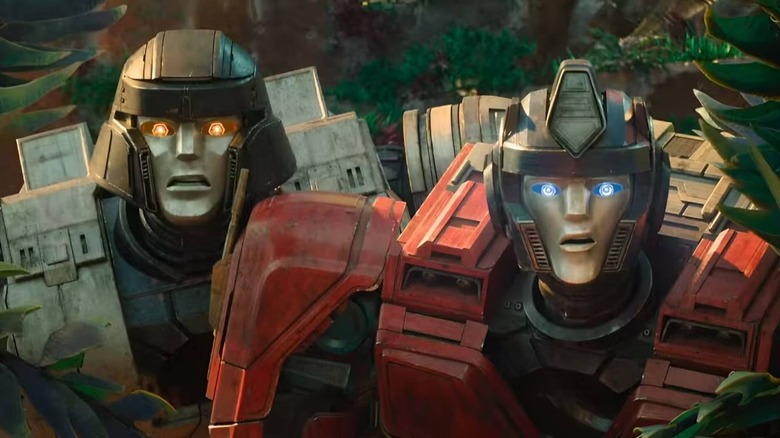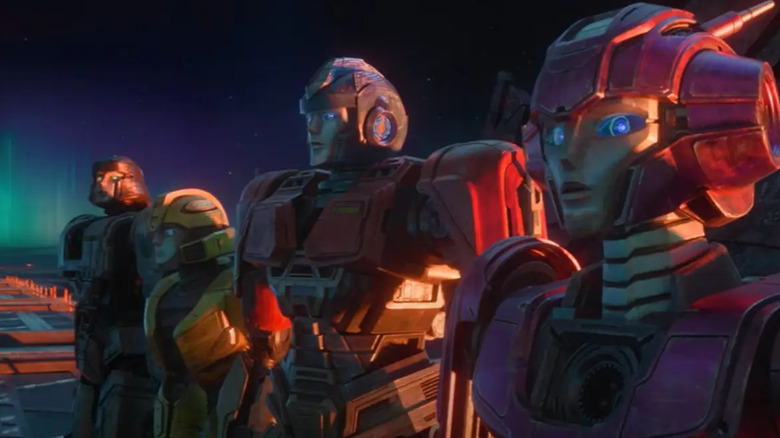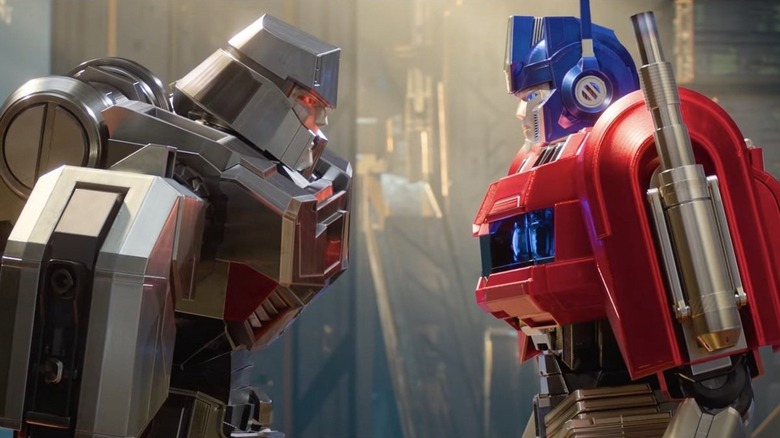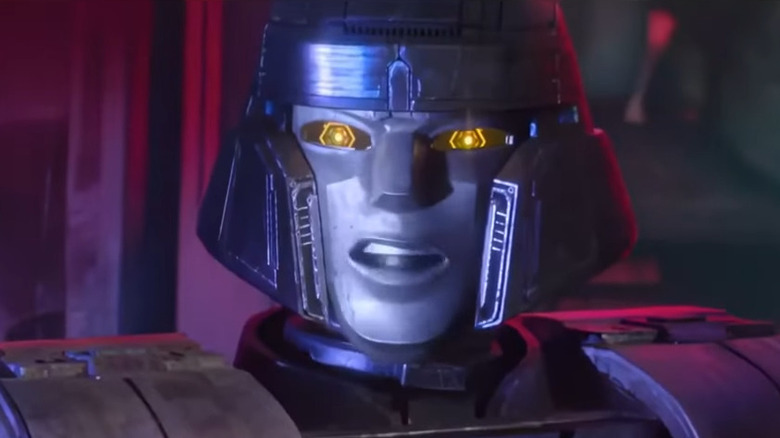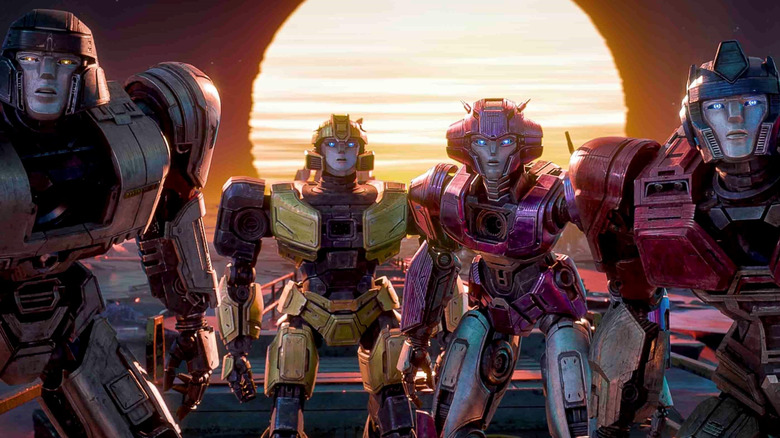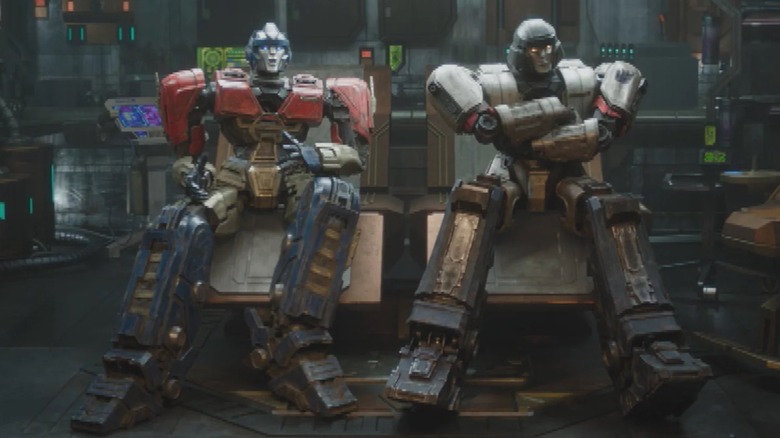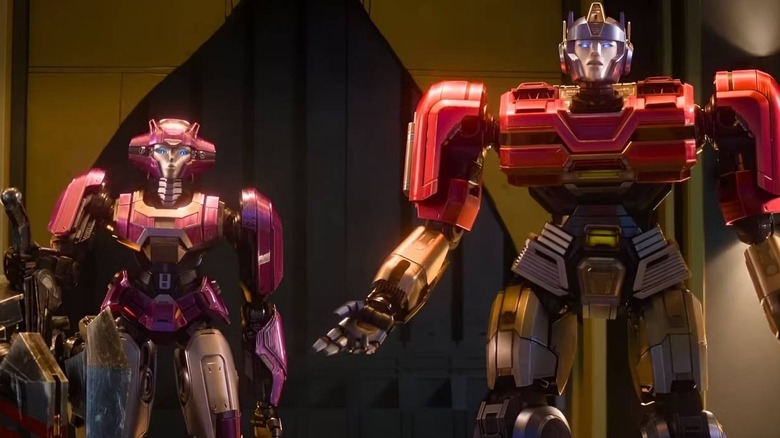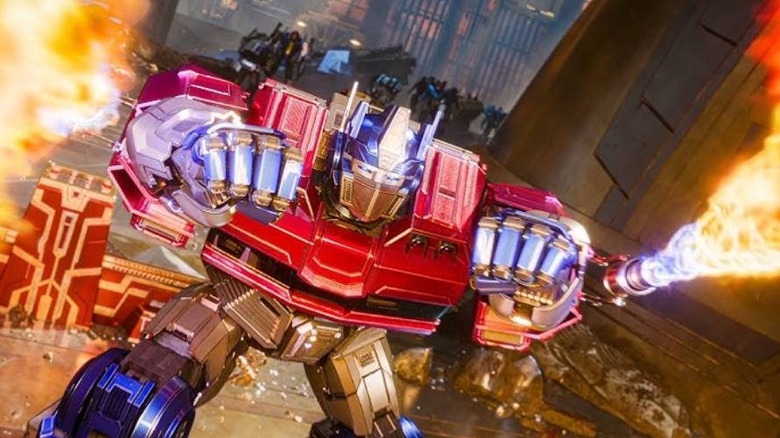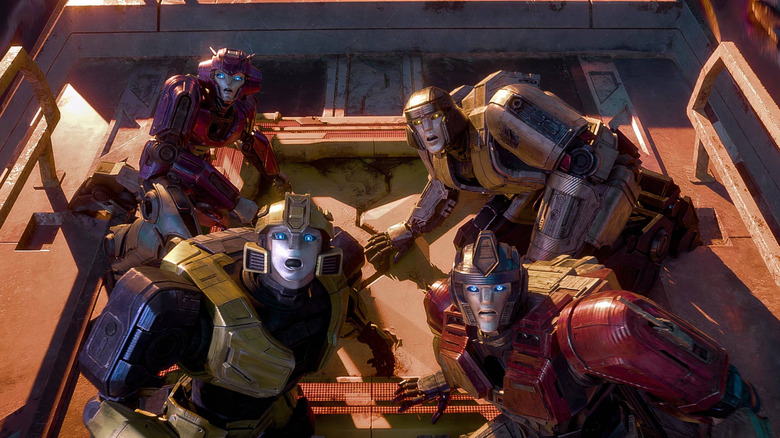The Ending Of Transformers One Explained
Note: Contains spoilers for "Transformers One."
One can't deny how massive Michael Bay's "Transformers" franchise became over the years, but even diehard fans would probably agree that every live-action "Transformers" movie has the same problem — there's too much focus on the human characters, turning the Transformers into side characters in their own stories. The series has the potential to be a giant science fiction epic, rather than standard action fare that happens to have some aliens that can turn into Ferraris. That's what makes "Transformers One" such a breath of fresh air.
It's the first theatrically-released animated film in the franchise since 1986's "The Transformers: The Movie." Instead of merely giving audiences brief flashbacks to the Transformers' homeworld of Cybertron, the entire story is set there. We get to see where these larger-than-life figures started, with Optimus Prime (Chris Hemsworth) and Megatron (Brian Tyree Henry) actually being friends earlier in their lives, back when they were known respectively as Orion Pax and D-16.
A sense of tragic dramatic irony permeates "Transformers One," since we have an idea of where these characters have to end up — as best friends destined to become bitter enemies. It's the kind of epic storytelling some have wanted out of a "Transformers" movie for years. If you have any questions by the time the final scene plays, here's everything to know.
What you need to remember about the plot of Transformers One
"Transformers One" begins with Orion Pax and D-16 as lowly miners. They're born without transformation cogs, meaning they can't turn into cool vehicles, so they must mine for Energon ever since it stopped flowing naturally with the Matrix of Leadership missing. But Orion Pax wants something more out of life, so he tricks D-16 into entering the Iacon 5000, where they compete against honest-to-goodness Transformers and end up making quite the spectacle.
Sentinel Prime (Jon Hamm) is impressed with how they inspire the other miners, but Darkwing (Isaac C. Singleton Jr.), upset at them for upstaging the Transformers, sends them to Sub-Level 50. There they meet B-127 (Keegan-Michael Key), later known as Bumblebee, and discover a map that could lead them to the Matrix of Leadership. They sneak aboard a train to Cybertron's surface along with Elita-1 (Scarlett Johansson), whom Orion and D-16 used to work with in the mines.
The quartet learn the truth from Alpha Trion (Laurence Fishburne), the last survivor of the Primes, whom Sentinel Prime betrayed to the Quintessons because he wants the Matrix of Leadership for himself. But it disappears after he kills the Primes, as it can only be wielded by someone truly worthy. Alpha Trion gives the four bots transformation cogs so that they can reveal the truth about Sentinel to Cybertron's citizens. D-16, feeling betrayed by Sentinel, goes down a dark path that's only exacerbated when they encounter the banished Cybertronian High Guard, including Starscream (Steve Buscemi). Sentinel initiates a blitz, capturing D-16, B-127, and many of the High Guard in the process. Orion Pax, Elita-1, and whatever forces they have left must now head back to Iacon City to take down Sentinel Prime.
What happened at the end of Transformers One?
Orion Pax and Elita-1 realize they can prove to everyone how evil Sentinel Prime is by acquiring footage captured by Sentinel's many-eyed bodyguard, Airachnid (Vanessa Liguori). Meanwhile, Sentinel brands D-16 with a crude drawing of Megatronus Prime, increasing his hatred. After catching Sentinel by surprise in his tower following an aerial battle, Orion is successful at uploading footage of Sentinel bowing to the Quintessons and talking about how he removed the miners' transformation cogs before they went online, artificially turning them into second-class citizens.
D-16 isn't done with Sentinel yet, but Orion wants him to show mercy, believing they have to set an example to lead Cybertron toward a better future. Orion goes so far as to take a shot that D-16 fires at Sentinel, and as D-16 is holding Orion over a pit, he lets go, completing his transformation into Megatron. As Orion falls, he sees the ghosts of the fallen Prime and is bestowed the name Optimus Prime, while also being given the Matrix of Leadership. Optimus comes back from the dead after Megatron rips Sentinel Prime in half in a very public execution. The two former friends do battle, with many on the High Guard taking Megatron's side while Optimus gets help from Elita-1 and B-127.
Optimus is victorious and banishes Megatron and his lackeys from Iacon City. Energon flows freely again, while everyone now has a transformation cog, able to pursue whatever path they want in life. Megatron's still out there, but Optimus Prime is dedicated to maintaining freedom and autonomy for all with a new faction of Transformers — the Autobots.
Does Transformers One have a post-credits scene?
The "Transformers" franchise regularly makes use of mid- and post-credit scenes, and "Transformers One" has one of each. Partway through the credits, we see B-127 meet up with the makeshift friends he's constructed out of junk to tell them all about the adventure he had, including the fact that he now has knife hands. While showing off his new weapons, he ends up slicing two of his buddies — but they're literally hunks of junk, so it's all played for laughs.
At the end of the credits is a scene that actually sets up future installments. Megatron is leading his new recruits, who naturally all need names. While we see the Transformers get branded, Megatron gives a speech about how Sentinel is dead, and they will rise up to overtake the new ruling power. He proclaims, "His death has given life to a new enemy ... We will not be blinded by his deception. We are the ones who are ... Decepticons!" Megatron now sees Optimus and his allies as no better than Sentinel Prime, giving the iconic villain personal motivation to attack the Autobots in a potential sequel.
Director Josh Cooley and producer Lorenzo di Bonaventura spoke at a recent Q&A about changing the two credit scenes around, since the darker one initially came in the middle, which was too soon after the triumphant finale. "We wanted the audience to have some fun," di Bonaventura explained. "And then, if you have the patience to wait 'til the end then you know what could be coming in the next movie."
What the end of Transformers One means
Before even walking into "Transformers One," most viewers probably have a good idea of how things will play out. By the end, Optimus Prime leads the Autobots, and we know from the post-credit scene that Megatron now has the Decepticons willing to do his bidding. Megatron has consistently proven himself to be the most powerful Decepticon in all of "Transformers" lore, and him killing Sentinel Prime makes it easy to get Starscream and the others on his side. There are now two factions prepared to go to war.
In previous "Transformers" canon, Autobot stands for "autonomous robotic organism," with "autonomous" referring to the ability to control one's affairs. It's an appropriate name given the events of "Transformers One," when the miners' autonomy is stripped from them by having their cogs removed as they are forced into lives of labor. Megatron dubbing his followers "Decepticons" could be seen as a sign that Megatron is still worried Optimus Prime will deceive the Transformers, so he rebels.
A good villain generally perceives themselves to be the hero of their own story. Megatron is ultimately tired of having others trying to govern him, so he became ungovernable. And he's not the only threat around, as the Quintessons are still out there and likely still expecting Energon payments. A sequel could see Optimus Prime tackling these two threats, with his ability to be an amazing leader getting tested.
There was a different idea for the end credits
"Transformers" is a nostalgic property for many, so it's understandable that there are quite a few Easter eggs throughout the movie. There could have been one more, with a version of the iconic theme song from the original 1980s series playing during the credits. But director Josh Cooley had a good reason to opt for something different.
In an interview with Gizmodo, Cooley explained that the theme song would have immediately started playing at the end of the movie. However, he had second thoughts: "After a while, after talking to [composer] Brian Tyler about it, it was like it's hitting the nostalgia so hard that it almost didn't feel like the movie anymore, if that makes sense," he said.
"Transformers One" isn't short on references, however, with Orion Pax at one point saying, "It's time to show that we are more than meets the eye." And if one looks closely at the leaderboard from the Iacon 5000, there are plenty of names that will certainly ring some bells, like Mirage, Clampdown, and Slingshot. It seems like homages to the original 1980s cartoon happen in every "Transformers" movie, whether it's live-action or animated, so it's good to see Cooley and the team knew when to hold back and let emotional resonance win over nostalgia bait.
The hardest part about getting the story just right
The tone for "Transformers One" naturally had to be different from what general audiences are used to in the live-action franchise. Every live-action "Transformers" movie is rated PG-13, so they can get away with stronger language and more intense action. "Transformers One" is only PG, but it still manages to pack some heavy themes into its runtime while still being perfectly suitable for young children. But getting the tone exactly right so that it didn't feel too "made for kids" was crucial.
During the Q&A that Looper attended, Josh Cooley revealed that an earlier version of the script leaned too far in the other direction. "Early on, the first draft of it, it was, I won't say this not in a bad way, but it was more cartoony," he explained. "After we put up the first version of it, it was like, 'Oh, this just doesn't feel right.' It didn't feel like 'Transformers.'"
The end result is something that balances the best of both worlds. There are still plenty of jokes, with B-127 serving as the comic relief, but there's still that undercurrent of darkness, especially as Orion Pax and D-16 slowly drift apart in their ideologies.
Why is Transformers One dedicated to Brian Goldner?
Many films and television episodes have dedications to people who were close to the production and passed away, and those who stick around for the "Transformers One" credits and pay attention may notice just such a special dedication to Brian Goldner. But who is he?
Goldner was the CEO for Hasbro, after previously working with Bandai. He was an instrumental figure in bringing Hasbro properties to the big screen, being an executive producer for all of the live-action "Transformers" films to date while also producing the likes of "Battleship," "G.I. Joe: The Rise of Cobra," and "Jem and the Holograms." He died on October 11, 2021 from prostate cancer at the age of 58.
These Hasbro cinematic productions owe a lot to Goldner, and he's already had several projects dedicated to his memory. "Transformers: Rise of the Beasts" ends with a dedication that calls Goldner "a passionate creator and loyal friend to Autobots and humans alike." Similar dedications can be found in "Dungeons and Dragons: Honor Among Thieves," "Transformers: Earthspark," and "The Rookie."
Is Transformers One connected to the live-action movies?
Even looking only at the movies directed by Michael Bay, the "Transformers" timeline quickly becomes tricky to explain. Fans may naturally wonder if any sequels to "Transformers One" could eventually lead to the events of the live-action films. The best answer would appear to be, "Don't count on it."
Speaking with ComicBook.com, Josh Cooley stated, "I wouldn't say that this is a direct prequel to anything that's been done with live-action ones, but it's definitely its own story as well." Even if it did technically exist in the same universe, it's set so far back on the timeline that there's still much to explore concerning Optimus Prime and Megatron's war against one another. Lorenzo di Bonaventura spoke at San Diego Comic-Con 2024 (via ScreenRant) about how far removed it is from anything else in the series, saying, "['Transformers One' takes place] 3 billion years before what we've done before."
If di Bonaventura is correct about just how far back "Transformers One" is set, there are still plenty of stories the creative team could tell on Cybertron without the Autobots and Decepticons ever having to go to Earth. It's safe to assume that if "Transformers One" gets any follow-ups, they'll remain their own thing separate from what's come before.
